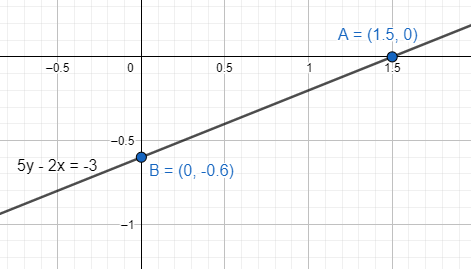Answer
384.3k+ views
Hint: Change of form of the given equation will give the slope of the line $5y-2x=-3$. The given equation $5y-2x=-3$ is of the form $ax+by=c$. We change it to the form of $y=mx+k$ to find the slope m. Then, we place the line on the graph based on that.
Complete step by step solution:
We are taking the general equation of line to understand the slope of the line $5y-2x=-3$.
The given equation $5y-2x=-3$ is of the form $ax+by=c$. Here a, b, c are the constants.
We convert the form to $y=mx+k$. m is the slope of the line.
So, converting the equation we get
$\begin{align}
& 5y-2x=-3 \\
& \Rightarrow 5y=2x-3 \\
& \Rightarrow y=\dfrac{2x-3}{5}=\dfrac{2}{5}x-\dfrac{3}{5} \\
\end{align}$
This gives that the slope of the line $5y-2x=-3$ is $\dfrac{2}{5}$.
We need to find the y intercept, and x-intercept of the line $5y-2x=-3$ to plot in the graph.
For this we convert the given equation into the form of $\dfrac{x}{p}+\dfrac{y}{q}=1$. From the form we get that the x intercept, and y intercept of the line will be p and q respectively.
The given equation is $5y-2x=-3$. Converting into the form of $\dfrac{x}{p}+\dfrac{y}{q}=1$, we get
$\begin{align}
& 5y-2x=-3 \\
& \Rightarrow \dfrac{-2x}{-3}+\dfrac{5y}{-3}=1 \\
& \Rightarrow \dfrac{x}{{}^{3}/{}_{2}}+\dfrac{y}{{}^{-3}/{}_{5}}=1 \\
\end{align}$
Therefore, the x intercept, and y intercept of the line $2x+y=5$ is $\dfrac{3}{2}$ and $\dfrac{-3}{5}$ respectively.
The intersecting points for the line $5y-2x=-3$ with the axes will be $\left( \dfrac{3}{2},0 \right)$ and $\left( 0,-\dfrac{3}{5} \right)$.

Note: A line parallel to the X-axis does not intersect the X-axis at any finite distance and hence we cannot get any finite x-intercept of such a line. Same goes for lines parallel to the Y-axis. In case of slope of a line the range of the slope is 0 to $\infty $.
Complete step by step solution:
We are taking the general equation of line to understand the slope of the line $5y-2x=-3$.
The given equation $5y-2x=-3$ is of the form $ax+by=c$. Here a, b, c are the constants.
We convert the form to $y=mx+k$. m is the slope of the line.
So, converting the equation we get
$\begin{align}
& 5y-2x=-3 \\
& \Rightarrow 5y=2x-3 \\
& \Rightarrow y=\dfrac{2x-3}{5}=\dfrac{2}{5}x-\dfrac{3}{5} \\
\end{align}$
This gives that the slope of the line $5y-2x=-3$ is $\dfrac{2}{5}$.
We need to find the y intercept, and x-intercept of the line $5y-2x=-3$ to plot in the graph.
For this we convert the given equation into the form of $\dfrac{x}{p}+\dfrac{y}{q}=1$. From the form we get that the x intercept, and y intercept of the line will be p and q respectively.
The given equation is $5y-2x=-3$. Converting into the form of $\dfrac{x}{p}+\dfrac{y}{q}=1$, we get
$\begin{align}
& 5y-2x=-3 \\
& \Rightarrow \dfrac{-2x}{-3}+\dfrac{5y}{-3}=1 \\
& \Rightarrow \dfrac{x}{{}^{3}/{}_{2}}+\dfrac{y}{{}^{-3}/{}_{5}}=1 \\
\end{align}$
Therefore, the x intercept, and y intercept of the line $2x+y=5$ is $\dfrac{3}{2}$ and $\dfrac{-3}{5}$ respectively.
The intersecting points for the line $5y-2x=-3$ with the axes will be $\left( \dfrac{3}{2},0 \right)$ and $\left( 0,-\dfrac{3}{5} \right)$.

Note: A line parallel to the X-axis does not intersect the X-axis at any finite distance and hence we cannot get any finite x-intercept of such a line. Same goes for lines parallel to the Y-axis. In case of slope of a line the range of the slope is 0 to $\infty $.
Recently Updated Pages
How many sigma and pi bonds are present in HCequiv class 11 chemistry CBSE

Why Are Noble Gases NonReactive class 11 chemistry CBSE

Let X and Y be the sets of all positive divisors of class 11 maths CBSE

Let x and y be 2 real numbers which satisfy the equations class 11 maths CBSE

Let x 4log 2sqrt 9k 1 + 7 and y dfrac132log 2sqrt5 class 11 maths CBSE

Let x22ax+b20 and x22bx+a20 be two equations Then the class 11 maths CBSE

Trending doubts
Fill the blanks with the suitable prepositions 1 The class 9 english CBSE

At which age domestication of animals started A Neolithic class 11 social science CBSE

Which are the Top 10 Largest Countries of the World?

Give 10 examples for herbs , shrubs , climbers , creepers

Difference between Prokaryotic cell and Eukaryotic class 11 biology CBSE

Difference Between Plant Cell and Animal Cell

Write a letter to the principal requesting him to grant class 10 english CBSE

Change the following sentences into negative and interrogative class 10 english CBSE

Fill in the blanks A 1 lakh ten thousand B 1 million class 9 maths CBSE



